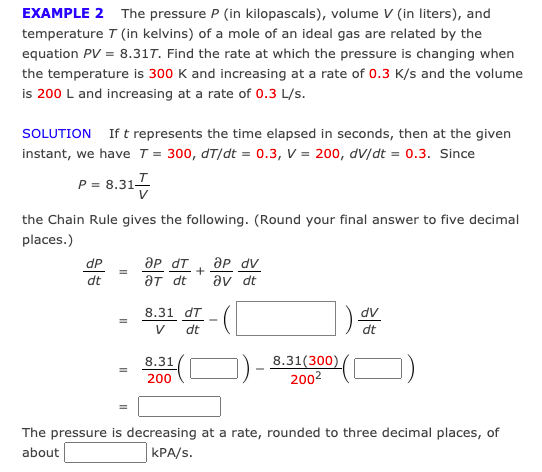EXAMPLE 2 The pressure P (in kilopascals), volume V (in liters), and temperature T (in kelvins) of a mole of an ideal gas are related by the equation PV = 8.317. Find the rate at which the pressure is changing when the temperature is 300 K and increasing at a rate of 0.3 K/s and the volume is 200 L and increasing at a rate of 0.3 L/s. SOLUTION If t represents the time elapsed in seconds, then at the given instant, we have T = 300, dT/dt = 0.3, V = 200, dv/dt = 0.3. Since P = 8.31, the Chain Rule gives the following. (Round your final answer to five decimal places.) ap dT aT dt ap dv av dt dP dt 8.31 dT dv V dt dt 8.31(300) 2002 8.31 200 The pressure is decreasing at a rate, rounded to three decimal places, of about kPA/s.
EXAMPLE 2 The pressure P (in kilopascals), volume V (in liters), and temperature T (in kelvins) of a mole of an ideal gas are related by the equation PV = 8.317. Find the rate at which the pressure is changing when the temperature is 300 K and increasing at a rate of 0.3 K/s and the volume is 200 L and increasing at a rate of 0.3 L/s. SOLUTION If t represents the time elapsed in seconds, then at the given instant, we have T = 300, dT/dt = 0.3, V = 200, dv/dt = 0.3. Since P = 8.31, the Chain Rule gives the following. (Round your final answer to five decimal places.) ap dT aT dt ap dv av dt dP dt 8.31 dT dv V dt dt 8.31(300) 2002 8.31 200 The pressure is decreasing at a rate, rounded to three decimal places, of about kPA/s.
Linear Algebra: A Modern Introduction
4th Edition
ISBN:9781285463247
Author:David Poole
Publisher:David Poole
Chapter6: Vector Spaces
Section6.7: Applications
Problem 13EQ
Related questions
Topic Video
Question
Solve all that is asked in the image

Transcribed Image Text:EXAMPLE 2 The pressure P (in kilopascals), volume V (in liters), and
temperature T (in kelvins) of a mole of an ideal gas are related by the
equation PV = 8.317. Find the rate at which the pressure is changing when
the temperature is 300 K and increasing at a rate of 0.3 K/s and the volume
is 200 L and increasing at a rate of 0.3 L/s.
SOLUTION If t represents the time elapsed in seconds, then at the given
instant, we have T = 300, dT/dt = 0.3, V = 200, dv/dt = 0.3. Since
P = 8.31-
the Chain Rule gives the following. (Round your final answer to five decimal
places.)
ap dT
aT dt
ap dv
av dt
dP
dt
8.31 dT
dv
V
dt
dt
8.31(300)
2002
8.31
200
The pressure is decreasing at a rate, rounded to three decimal places, of
about
kPA/s.
Expert Solution
This question has been solved!
Explore an expertly crafted, step-by-step solution for a thorough understanding of key concepts.
This is a popular solution!
Trending now
This is a popular solution!
Step by step
Solved in 2 steps with 2 images

Knowledge Booster
Learn more about
Need a deep-dive on the concept behind this application? Look no further. Learn more about this topic, calculus and related others by exploring similar questions and additional content below.Recommended textbooks for you

Linear Algebra: A Modern Introduction
Algebra
ISBN:
9781285463247
Author:
David Poole
Publisher:
Cengage Learning

Big Ideas Math A Bridge To Success Algebra 1: Stu…
Algebra
ISBN:
9781680331141
Author:
HOUGHTON MIFFLIN HARCOURT
Publisher:
Houghton Mifflin Harcourt

Algebra & Trigonometry with Analytic Geometry
Algebra
ISBN:
9781133382119
Author:
Swokowski
Publisher:
Cengage

Linear Algebra: A Modern Introduction
Algebra
ISBN:
9781285463247
Author:
David Poole
Publisher:
Cengage Learning

Big Ideas Math A Bridge To Success Algebra 1: Stu…
Algebra
ISBN:
9781680331141
Author:
HOUGHTON MIFFLIN HARCOURT
Publisher:
Houghton Mifflin Harcourt

Algebra & Trigonometry with Analytic Geometry
Algebra
ISBN:
9781133382119
Author:
Swokowski
Publisher:
Cengage

Functions and Change: A Modeling Approach to Coll…
Algebra
ISBN:
9781337111348
Author:
Bruce Crauder, Benny Evans, Alan Noell
Publisher:
Cengage Learning
